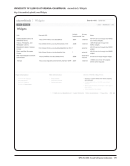SPEC Kit 304: Social Software in Libraries · 97
Grassroots nature --individual librarians
can use social software tools as needed
and as appropriate. Because we are a
large, decentralized system there is no
“one size fits all” approach. FC
Presence in the user’s space, if they
choose to add us (e.g., Facebook/Google
widgets).
VPA
With QuestionPoint we have 24/7 chat
service, something we could not easily
staff ourselves or manage in a physical
environment.
VPA
Helps keep library staff up-to-date with
emerging technologies. SS
Improved information sharing among
staff. Fewer meetings. SI
Provides online presence of library to user
community beyond Web site. VPA
Helps us put our services “where users
are”... such as the integration between
Amazon and our catalog via the LibX
extension. VPA
Helps market library services and increase
awareness.
PR
Helps us leverage the contributions of our
user community.
CC
Improve virtual library services Increase
discovery of library resources and services
outside the library’s Web site or physical
space (catalog feed, news feed, IM
reference). RD
Fill service gap on campus and meet
student demand (blogs, Wikis) Facilitate
student-to-student collaboration.
Col
Advance skill knowledge of digital library
development tools, leading to ideas for
new services, better integration with
users’ online spaces.
VPA, IS
Improved services for library users —
higher level of interaction, ability to
provide better, faster, and more relevant
services. IS
Increased collaboration among faculty and
staff — more information-sharing, better
communication.
Com, Col, SI
Increased feedback and measurement
opportunities in order to improve services.
IS, UF
Increased 2-way communication with
users or between staff members.
Com
Increased PR and marketing on a budget.
PR
Feedback, suggestions, and
communication with other libraries and
professionals as they read or see our
content, which results in improvements for
our users. Com, UF
Increased communication with students
and faculty.
Com
Promotion of library services.
PR
Making it easier and convenient for
students to use library services and
resources from home. VPA
Increased communication.
Com
Improved user satisfaction with, and
awareness of, library services and
resources as well as positive improvement
of the library’s image among students.
PR, IS, RD
Increased development of Web resources
(because the social software tools
have significantly reduced the technical
expertise previously necessary for
publishing content on the Web). EZ
Increased visibility for the Libraries.
VPA
Integrating library services in the spaces
where our users are. VPA
Just in time service, provides critical
services at point of need. IS
Grassroots nature --individual librarians
can use social software tools as needed
and as appropriate. Because we are a
large, decentralized system there is no
“one size fits all” approach. FC
Presence in the user’s space, if they
choose to add us (e.g., Facebook/Google
widgets).
VPA
With QuestionPoint we have 24/7 chat
service, something we could not easily
staff ourselves or manage in a physical
environment.
VPA
Helps keep library staff up-to-date with
emerging technologies. SS
Improved information sharing among
staff. Fewer meetings. SI
Provides online presence of library to user
community beyond Web site. VPA
Helps us put our services “where users
are”... such as the integration between
Amazon and our catalog via the LibX
extension. VPA
Helps market library services and increase
awareness.
PR
Helps us leverage the contributions of our
user community.
CC
Improve virtual library services Increase
discovery of library resources and services
outside the library’s Web site or physical
space (catalog feed, news feed, IM
reference). RD
Fill service gap on campus and meet
student demand (blogs, Wikis) Facilitate
student-to-student collaboration.
Col
Advance skill knowledge of digital library
development tools, leading to ideas for
new services, better integration with
users’ online spaces.
VPA, IS
Improved services for library users —
higher level of interaction, ability to
provide better, faster, and more relevant
services. IS
Increased collaboration among faculty and
staff — more information-sharing, better
communication.
Com, Col, SI
Increased feedback and measurement
opportunities in order to improve services.
IS, UF
Increased 2-way communication with
users or between staff members.
Com
Increased PR and marketing on a budget.
PR
Feedback, suggestions, and
communication with other libraries and
professionals as they read or see our
content, which results in improvements for
our users. Com, UF
Increased communication with students
and faculty.
Com
Promotion of library services.
PR
Making it easier and convenient for
students to use library services and
resources from home. VPA
Increased communication.
Com
Improved user satisfaction with, and
awareness of, library services and
resources as well as positive improvement
of the library’s image among students.
PR, IS, RD
Increased development of Web resources
(because the social software tools
have significantly reduced the technical
expertise previously necessary for
publishing content on the Web). EZ
Increased visibility for the Libraries.
VPA
Integrating library services in the spaces
where our users are. VPA
Just in time service, provides critical
services at point of need. IS




































































































































































































